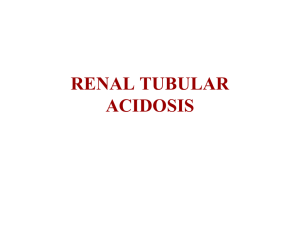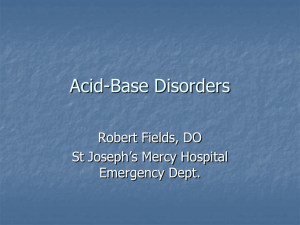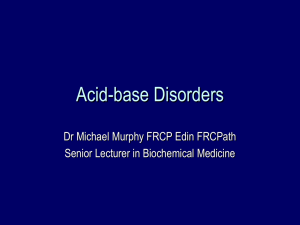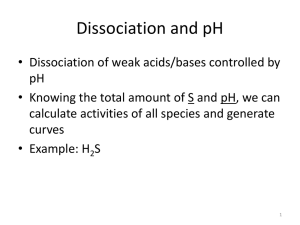Exercises in Acid
advertisement
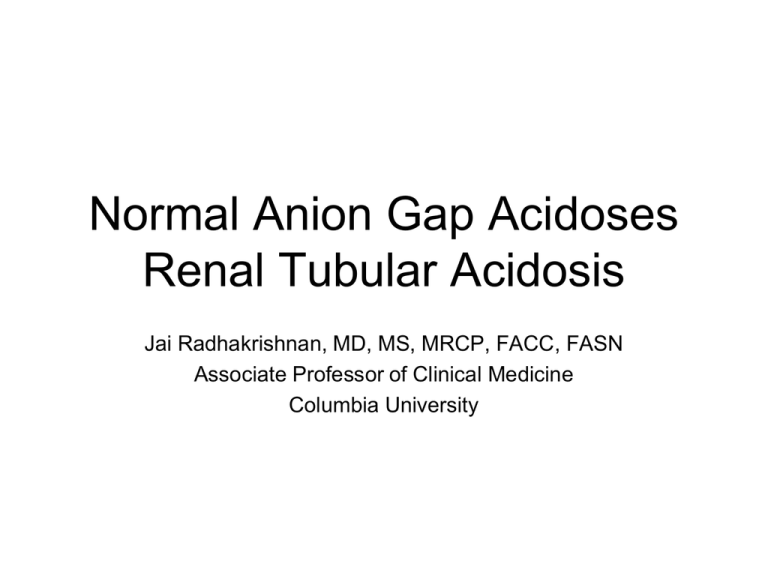
Normal Anion Gap Acidoses Renal Tubular Acidosis Jai Radhakrishnan, MD, MS, MRCP, FACC, FASN Associate Professor of Clinical Medicine Columbia University Disclosures • None Objective • Physiology of renal acid handling • Diagnostic approach to Metabolic Acidosis with normal anion gap. • Case-based diagnostic workup of the RTA’s Chemistry: Carbonic Acid • Carbonic Acid. – [ H+ ] x [ HCO3- ] = k1 x H2CO3 = k2 x [ CO2 ] x [ H2O ] • Simplified – H2CO3 is not of clinical interest – [H2O] is constant in-vivo – PCO2 is more familiar than [CO2]: • [ H+ ] x [ HCO3- ] = k x PCO2 • [ Modified Henderson Equation. ] • Hasselbalch Modification 4 Metabolic Acidosis: The “Anion Gap” [Na+] - ([Cl-] + [HCO3-]) ~ 10-12 mM/L Alb- AlbHCO3- HCO3Na+ Na+ Cl- Cl- Nl Anion gap M acidosis Etiology of “normal anion gap” (A.K.A. “hyperchloremic”) metabolic acidosis 1. GI bicarbonate loss (typically also with low K): diarrhea villous adenoma pancreatic, biliary, small bowel fistulae uretero-sigmoidostomy obstructed uretero-ileostomy GI Loss of HCO3- Pancreas Pancreas HCO3- Ileum HCO3- HCO3- Ileum Cl- Cl- Cl- Normal Colon K+ HCO3- Diarrhea Colon HCO3- Flooding the colon with instead of Cl- drives K+ secretion Na+ K+ HCO3- Cl- K+ Na+ K+ Uretero-ileostomy Causes a Normal Anion Gap Acidosis HCO3- Skin Cl- ileal loop Causes of a “normal anion gap” (A.K.A. “hyperchloremic”) metabolic acidosis 2. Ingestions & infusions ammonium chloride hyperalimentation (arginine/lysine-rich) 3. Renal bicarbonate (or equivalent) loss • proximal RTA • distal RTA • type IV RTA early renal failure acetazolamide hydrated DKA Proximal RTA (“Type II”) HCO3 Na+ - H+ H+ (1) Na+ (3) HCO3- CO2 + H2O Na+ HCO3glucose amino acids urate phosphate Defective Na+ - dependent resorption = Fanconi’s Syndrome Distal RTA Na+ Na+ K+ K+ Principal cell Aldosterone ATP H+ HCO3- ADP + Pi ClCl- a IC cell Cl- Cl- HCO3- ATP H+ ADP + Pi b IC cell Net acid excretion = urinary NH4+ + urinary “titratable acid” (H2PO4-) urinary HCO3NH4+ NH3 + H2PO4- HPO4-- + H+ + Not titratable; need to measure HCO3- Titratable acid Present in Prox RTA H2CO3 Hyperkalemic distal RTA: Na+ Na+ K+ K+ Principal cell Aldosterone ATP H+ HCO3- ADP + Pi ClCl- a IC cell Cl- Cl- HCO3- ATP H+ ADP + Pi b IC cell ACIDOSIS IN HYPORENINEMIC HYPOALDOSTERONISM 5. Total Body K+ Excess Decreases Proximal Tubule Acidification and Ammoniagenesis via Intracellular Alkalosis HCO3 Na+ - H+ H+ (1) Na+ (3) HCO3- CO2 + H2O 1. Failed CCD K+ secretion 2. Total body K+ excess 3. K+ entry into proximal tubule cells K+ H+ 4. Alkalinization of prox tubule cell by K+/H+ exchange DIAGNOSTIC APPROACH Minimum Urine pH Urinary Anion Gap Plasma potassium Renal stones or Nephrocalcinosis Prox. Tubular dysfunction FEHCO3 Daily bicarbonate replacement needs Urine pH vs. Plasma bicarbonate in RTA Urine pH Normal Proximal RTA Distal RTA Plasma [HCO3-] mM (Oxford Textbook of Nephrology - Soriano et al, 1967) Urinary Anion Gap • Urine (Na+K) – Cl Unmeasured anions-unmeasured cations • Proton is partially excreted as NH4 (unmeasured cation) • The gap is usually Zero or Negative • In dRTA the anion gap will remain zero or positive • In other acidoses, the gap will become more negative. 19 A positive urine anion gap ~ no NH4+Cl excretion (i.e. low renal tubule acidification) Normal acidotic: closed circles Diarrhea: closed triangles Type 1 or IV RTA: open circles Battle et al, NEJM 1988 Proximal RTA: Hypokalemia Flooding the distal tubule with HCO3- instead of Cl- in Proximal RTA drives K+ secretion Na+ K+ HCO3- Cl- K+ Na+ K+ Distal RTA: Hypokalemia H + no longer shunts Na + current so K+ must do so Na+ Na+ K+ K+ Principal cell Aldosterone ATP H+ HCO3- ADP + Pi ClCl- a IC cell Cl- Cl- HCO3- ATP H+ ADP + Pi b IC cell Hyperkalemic Distal RTA Na+ Na+ K+ K+ Principal cell Low Aldosterone Voltage defect Aldosterone ATP H+ HCO3- ADP + Pi ClCl- a IC cell Cl- Cl- HCO3- ATP H+ ADP + Pi b IC cell Nephrocalcinosis/Kidney Stones • Distal RTA (High Incidence) – Alkaline urine: Calcium phosphate precipitation – Acidosis: Increased citrate reabsorption by proximal nephron • Proximal RTA (Not Seen): – Urine pH not high – Citrate not absorbed FANCONI’S SYNDROME only in Proximal RTA HCO3 Na+ - H+ H+ (1) Na+ (3) HCO3- CO2 + H2O Na+ HCO3glucose amino acids urate phosphate Defective Na+ - dependent resorption = Fanconi’s Syndrome Fractional excretion of HCO3- Fractional excretion of HCO3- Daily HCO3 Requirements • Proximal – >4 meq/kg • Distal – 1-2 meq/kg • Hyperkalemic – 1-2 meq/kg J Am Soc Nephrol 13:2160-2170, 2002 Positive Urinary anion gap Urine pH & plasma [K+] Urine pH < 5.5 & high[K+] Urine pH > 5.5 & low/nl[K+] Hypoaldosteronism RTA(type IV) Distal RTA (“Type I”): secretory or gradient defect Case 1 • • • A 55-year-old woman presents with complaints of lethargy, thirst, muscle weakness and generalized body pains. Previous ED visits with hypokalemia. Her serum potassium level was 2.6 mmol/l. Proximal RTA Other Electrolytes: – – – – – • • sodium 138 mmol/l chloride 116 mmol/l HCO3 17 mmol/l BUN/Creatinine normal Glucose 75mg/dL Urine analysis: pH 5.4, 2+ glucose Urine anion gap: -20 ABG: pH 7.25 pCO2 28 pO 2 100 total bicarbonate 15.1 mmol/l base excess –13.7 mmol/l Case 1: Proximal RTA Minimum Urine pH <5.5 Plasma potassium Low-normal Renal stones/NC Prox. Tubular dysfunction FEHCO3 Daily bicarbonate replacement needs No Glycosuria, Phosphate, AA, Urate 15-20% >4 mmol/kg FEHCO3 • Intravenous infusion of sodium bicarbonate at a rate of 0.5 to 1.0 meq/kg per hour • UHCO3 x PCr ——————————— PHCO3 x UCr • Proximal RTA: FE HCO3>15-20% FEHCO3 = x 100 Clinical Features of Proximal RTA • Urine pH depends on plasma [HCO3-] • Fractional HCO3- excretion high (15-20%) at nl plasma [HCO3-] • Plasma [K+] reduced, worsens with HCO3- therapy • Dose of daily HCO3- required: 10-15 mEq/kg/d • Non-renal: rickets or osteomalacia Causes of Proximal RTA • Primary isolated proximal RTA – hereditary (persistent) • a. autosomal dominant • b. autosomal recessive associated with mental retardation and ocular abnormalities – Sporadic (transient in infancy) • Secondary proximal RTA – in the context of Fanconi syndrome (cystinosis, galactosemia, fructose intolerance, tyrosinemia, Wilson disease, Lowe syndrome, metachromatic leukodystrophy, multiple myeloma, light chain disease) – drugs and toxins (acetazolamide, outdated tetracycline, aminoglycoside antibiotics, valproate, 6-mercaptopurine, streptozotocin, iphosphamide, lead, cadmium, mercury) – other clinical entities (vitamin D deficiency, hyperparathyroidism, chronic hypocapnia, Leigh syndrome, cyanotic congenital heart disease, medullary cystic disease, Alport syndrome, corticoresistant nephrotic syndrome, renal transplantation, amyloidosis, recurrent nephrolithiasis) J Am Soc Nephrol 13:2160-2170, 2002 Case 2 • A 38-year-old woman was admitted with severe weakness (3rd episode) • PMH: artificial tears for dry eyes • Laboratory Distal RTA – – – – – – Urine pH 7.1 sodium 141 mEq/L potassium 3.0 mEq/L carbon dioxide 14 mEq/L chloride 114 mEq/L S creatinine 0.8 mg/dL (70.7 µmol/L) – Albumin 4.3 – Urinary anion gap +4 Arch Intern Med. 2004;164:905-909 Case 2: Distal RTA Minimum Urine pH >5.5 Plasma potassium Lownormal Renal stones/NC Prox. Tubular dysfunction FEHCO3 Daily bicarbonate replacement needs YES No <3% <4 mmol/kg Arch Intern Med. 2004;164:905-909 Nephrocalcinosis/Recurrent Stones Consider Distal RTA Furosemide/Fludrocortisone Test • Baseline urine sample • Oral administration of furosemide (40 mg) and fludrocortisone (1 mg). • Fluid intake ad libitum. • Urine q1h x 6 h after the baseline sample. • Failed to acidify their urine to pH<5.3 Kidney International (2007) 71, 1310–1316 • Schirmer’s test positive • antibodies to the Ro/SSA and La/SSB + • Cryocrit + Causes of distal RTA J Am Soc Nephrol 13:2160-2170, 2002 Case 3 50 year old male with NIDDMhas been prescribed a low Na diet for HTN. He presents to the ER with marked weakness. Labs: 130|98|18 280 8.0 |20|1.3 Urine pH 5.0, 1+ protein Urine Na130, K 15, Cl 120 Case 3 50 year old male with NIDDMhas been prescribed a low Na diet for HTN. He presents to the ER with marked weakness. Labs: 130|98|50 280 8.0 |20|1.3 Urine pH 5.0, 1+ protein Hyperkalemic Minimum Urine pH <5.5 Plasma potassium High Renal stones/NC No Prox. Tubular dysfunction No FEHCO3 Daily bicarbonate replacement needs <3% <4 mmol/kg Type IV RTA: Etiology • Aldosterone – Hyporenin/hypoaldo (CKD) – Addison – Congenital :enzymes • Voltage – PHA – Drugs: TMP, K-sparing, pentamidine CNI (Na-K ATPas) • Multiple: Tubulointerstitial disease RTA Distal Proximal UAG neg Hyperkalemic Minimum Urine pH >5.5 +/- <5.5 <5.5 Plasma potassium Lownormal Low-normal High YES No No No Glycosuria, Phosphate, AA, Urate No <3% 15-20% <3% <4 mmol/kg >4 mmol/kg <4 mmol/kg Renal stones/NC Prox. Tubular dysfunction FEHCO3 Daily bicarbonate replacement needs

